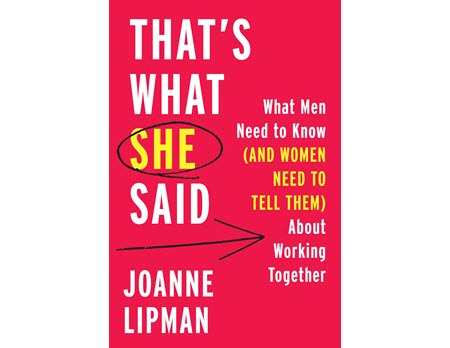Some On-the-Job Gender Training

Amidst the wave of stories behind the #MeToo movement, most empathetic, supportive men are trying to find meaning in this watershed moment, including the silent majority who know appropriate respectful behavior in the workplace is a no-brainer. But as the issue becomes a galvanizing force in the culture, most of us could still learn a thing or two about the broader — and more subtle — forms of sexual discrimination. Those transgressions are often made in the language we use and the way we speak to one another, says veteran journalist and author Joanne Lipman. In a timely book being released this week, That’s What She Said: What Men Need to Know (and Women Need to Tell Them) About Working Together (William Morrow), Lipman argued, “men can and must join the conversation” and she suggests things men can do in the workplace to bridge the gaping gender gap.
Related: #MeToo: A Moment or a Movement?|With #MeToo, TV Hits the ‘Reset Button’
In the well-researched book, Lipman, who served most recently as chief content officer of Gannett and editor in chief of USA Today, steers the conversation into the more relentless problems of language that permeate workplace culture from Hollywood to low-level, unglamorous jobs.
Lipman, former deputy managing editor of The Wall Street Journal, spoke with Mark Robichaux, editorial director of B&C and Multichannel News, about some of the most common communications challenges — and how to overcome them. Here’s an edited transcript.
MCN:Your timing for this book seems impeccable, although one assumes this has been on your mind for a while.
Joanne Lipman: This actually grew out of an article that I wrote in The Wall Street Journal more than three years ago out called, “Women at Work: A Guide for Men.” And the reason that I wrote the article, and subsequently the book, is because women talk about the issues that we face at work constantly — like being overlooked, or marginalized, or interrupted.
There are a lot of books and conferences for women, and so we talk to each other. What we don’t do is talk to men about these issues. And when women only talk to [each other], it’s only half of a conversation and it can at best solve only half of the problems. And really, we need men to join that conversation.
MCN:What kind of suggestions for closing the workplace gender gap do you offer in the book?
JL: Here’s an example of something that has happened to pretty much every woman: She has an idea in a meeting and it’s “crickets.” And then, five minutes later, a man repeats the exact same idea and he’s a genius. Everybody says, “Oh my gosh, Bob has a brilliant idea.”
So one of the things that I talk about is “amplification,” which is basically: A woman has an idea; somebody else in the room — could be a man or woman — repeats that idea and says, “Hey, Olivia had a great idea,” and gives her credit for it so that people understand it’s her idea.
MCN:How can women help each other in the office?
JL: Many women have trouble talking about their achievements in the workplace, in part because research shows it’s seen as bragging or being boastful.
So there’s a strategy called “brag buddies,” which is, I tell you my achievements, and you tell me your achievements. And each of us goes and brags about each other to the bosses. And it works particularly for women because the research shows that women are not as effective as men — even when they read from the same script — in, for example, asking for more money. But they are as effective or more when they advocate on behalf of others. So this brag buddies idea takes advantage of that because you’re advocating on behalf of somebody else.
MCN:How can a manager get a better handle on these issues?
JL: I think that at this point a lot of people understand that if you’re hiring you should have a diverse slate of candidates; it should not be all white men, for example. But what I’ve learned in reporting this was that that is not enough. You need to have a diverse slate of interviewers.
In other words, if you think you’ve got diverse candidates, but it’s a bunch of white men interviewing them, you’re still not going to come up with the best solution. This actually changed the way I manage. I brought that with me when I joined Gannett as chief content officer and editor in chief of USA Today. I brought with me that realization that when hiring people, make sure that I had a mixed group — ethnicity, gender, even age, just to get different perspectives. It was a highly useful tool that all managers should use.
MCN:Generally speaking, have men gotten better at picking up cues?
JL: It’s not just language — it’s how we think. There’s a lot of unconscious bias, which I talk about a lot in the book, which is the implicit bias in us. They are buried inside of us so deeply that we don’t even know they are there, and men have them as well as women. You can take a test on the internet called the implicit association test. I took the one for working women and I came out as moderately biased against working women. [Laughs.] So we all have these biases. The trick is to be more aware of them and overcome them.
Multichannel Newsletter
The smarter way to stay on top of the multichannel video marketplace. Sign up below.
